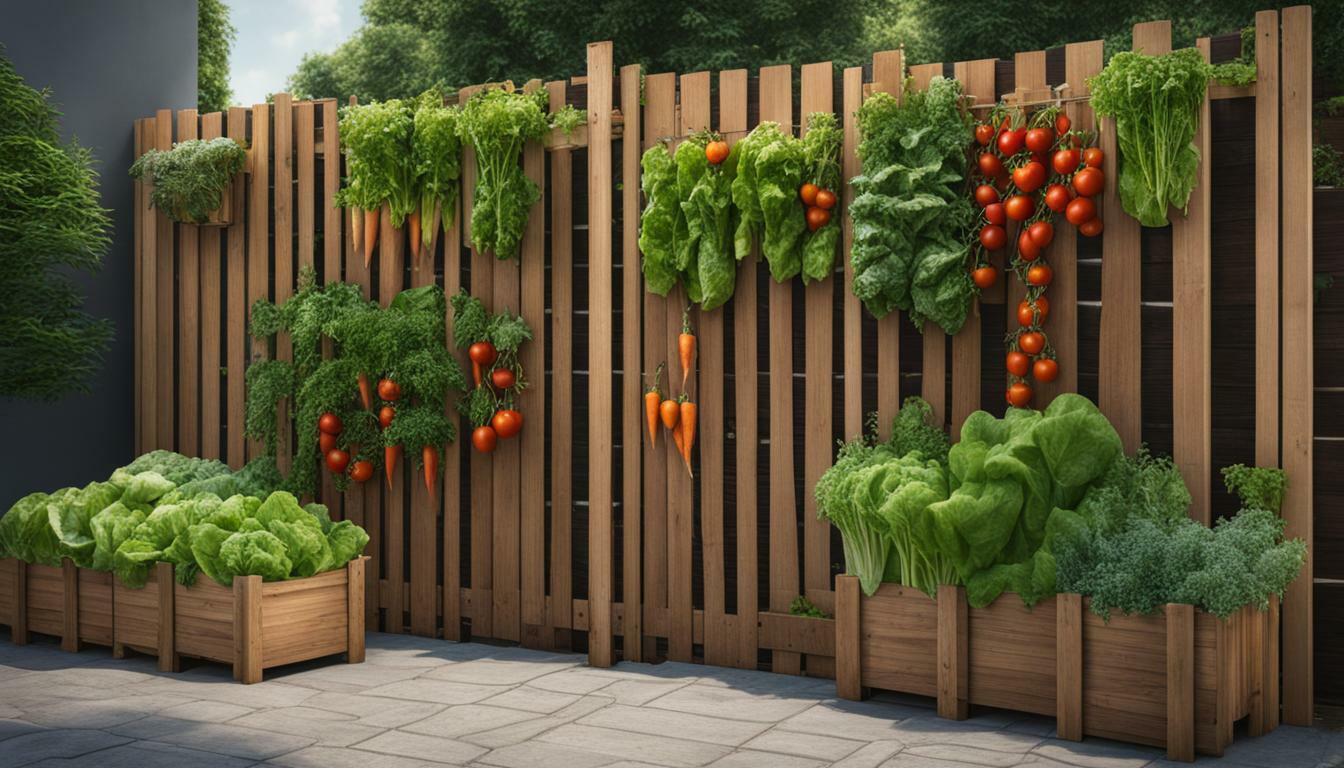Are you looking to make the most of your gardening space? Consider creating a fence vertical vegetable garden to maximize your growing area while saving space in your backyard. With a fence vertical vegetable garden, you can utilize your existing fence or other vertical structures to grow a variety of vegetables, making use of vertical space that would otherwise go unused. This innovative gardening technique not only helps maximize your yield but also minimizes pests and diseases for certain crops. Read on to discover the benefits of a fence vertical vegetable garden and how to get started.
Key Takeaways:
- Creating a fence vertical vegetable garden allows you to maximize space by utilizing vertical structures such as fences, trellises, and arbors.
- Vertical gardening can save you time and money by increasing your yield in a smaller area.
- Certain crops, such as cucumbers, pole beans, peas, squash, tomatoes, melons, and pumpkins, thrive in a fence vertical vegetable garden.
- Wood fencing, chain-link fencing, and solid cement wall fences can all be repurposed as vertical gardening structures.
- Choose the right crops for vertical gardening and consider the type of structure that best suits their growth characteristics.
- There are various DIY vertical gardening ideas that you can implement using fences and other materials in your backyard.
By maximizing your gardening space with a fence vertical vegetable garden, you can enjoy a bountiful harvest while utilizing vertical space that would otherwise go unused. With the right crops, structures, and creative ideas, you can transform your fence into a thriving vertical garden. Start maximizing your gardening potential today!
Benefits of a Fence Vertical Vegetable Garden
A fence vertical vegetable garden offers numerous benefits, including saving space, boosting the appeal of your home, and providing an opportunity to grow fresh produce right in your backyard. By utilizing the vertical space on your fence, you can maximize your gardening potential and enjoy the following advantages:
- Increased Yield: Growing vegetables vertically allows you to make the most of limited space, resulting in a heartier harvest. With plants reaching higher levels, you can minimize the need for bending and kneeling during maintenance and harvesting.
- Prevents Pests and Diseases: When plants are lifted off the ground, they are less susceptible to pests and diseases. The increased airflow around the foliage reduces the risk of soil-borne diseases, such as powdery mildew and rusts, while also making it easier to spot and address any issues.
- Improved Sun Exposure: By growing vertically, more leaf surface is exposed to the sun, promoting healthier growth. Plants receive the necessary sunlight for photosynthesis, resulting in robust and productive vegetation.
- Easier Maintenance: Vertical gardening eliminates the need for extensive ground-level maintenance. With plants growing at eye level or above, tending to them becomes more convenient, reducing strain on your back and knees.
Whether you have a solid wood fence, chain-link fencing, or a concrete wall, you can transform it into a thriving vertical garden. Utilizing hanging baskets, pots, trellises, or other support structures, you can cultivate a variety of vegetables, herbs, and fruits. Lettuce, radishes, strawberries, and herbs are well-suited for container gardening, while climbing vegetables like cucumbers, pole beans, and tomatoes thrive when given the support of trellises or grid-type materials.
Chain-link fencing, despite its initial appearance, can be a valuable vertical garden structure. Its open design allows for excellent support for climbing plants, and when fully covered with foliage, it transforms into an attractive green wall. However, keep in mind that most vegetable plants are annuals and will need to be removed and replaced each season.
If you have a solid cement wall fence, you can take advantage of its flat and secure top surface. By placing rectangular planter boxes along the top of the wall, you can create an instant vertical garden. This setup is perfect for growing peas, as the pods can be easily harvested as they grow down the wall.
Remember, vertical gardening offers a wealth of untapped gardening space. By thinking vertically, you can unlock the hidden potential of your fences and enjoy a bountiful and visually appealing garden right at home.
Quotes:
“Growing vegetables vertically saves space, time, and money. As an added perk, it also minimizes pests and disease for food crops such as cucumbers, pole beans, peas, squash, tomatoes, melons, and pumpkins.” – Source 1
“Gardening in all three dimensions by using a fence, trellis, or other structure increases the growing area available to gardeners. Here are just a few of the benefits of vertical gardening.” – Source 2
Image:
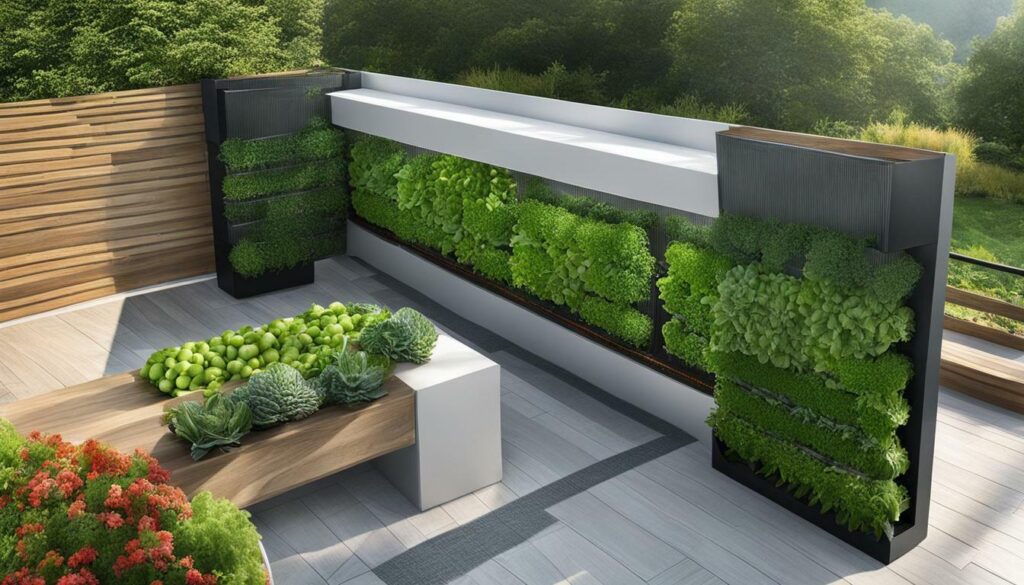
Utilizing Existing Fences for Vertical Gardening
If you have existing fences in your yard or garden, you can repurpose them for vertical gardening by attaching hanging baskets, pots, or other growing containers to them. This allows you to maximize your available space and create a stunning display of plants and vegetables.
Fences made of solid wood panels provide a versatile surface for vertical gardening. By attaching hanging baskets, pots, or other containers to the fence, you can grow a variety of plants such as lettuce, radishes, strawberries, and herbs. This method is particularly suitable for plants that thrive in containers and don’t require climbing support.
For fences made with flat boards that don’t offer support for climbing plants, you can attach a trellis or grid-type material. This provides a structure for climbing vegetables to grow and thrive. Additionally, fences with both vertical and horizontal materials can be used to hang planters and still be easily accessible to the gardener.
Chain-link fencing, often considered unattractive, can be transformed into a vertical garden structure. It provides an ideal support system for climbing plants and can be visually appealing when vines with full foliage are planted against it. While it may require some effort to remove dead vines at the end of the season, the benefits of using chain-link fencing for vertical gardening outweigh this inconvenience.
Table 1: Best Plants for Vertical Gardening on Fences
| Plant | Ideal Fence |
|---|---|
| Cucumbers | Solid wood panel or chain-link fencing |
| Pole beans | Flat board fence with attached trellis |
| Tomatoes | Chain-link fencing or trellis |
| Herbs | Solid wood panel or picket fence with hanging planters |
“By thinking vertically, you’ll find a surprising amount of gardening space where there was none before.” – Unknown
When utilizing existing fences for vertical gardening, it is important to choose plants that are best suited for this growing method. Vining and climbing vegetables like cucumbers, pole beans, and tomatoes are ideal for vertical gardening on fences. Additionally, herbs and other small plants that thrive in containers can also be grown vertically on fences.
By repurposing your existing fences, you can transform them into functional and aesthetically pleasing vertical gardens. Utilizing vertical space not only maximizes your gardening potential but also adds beauty and greenery to your outdoor space.
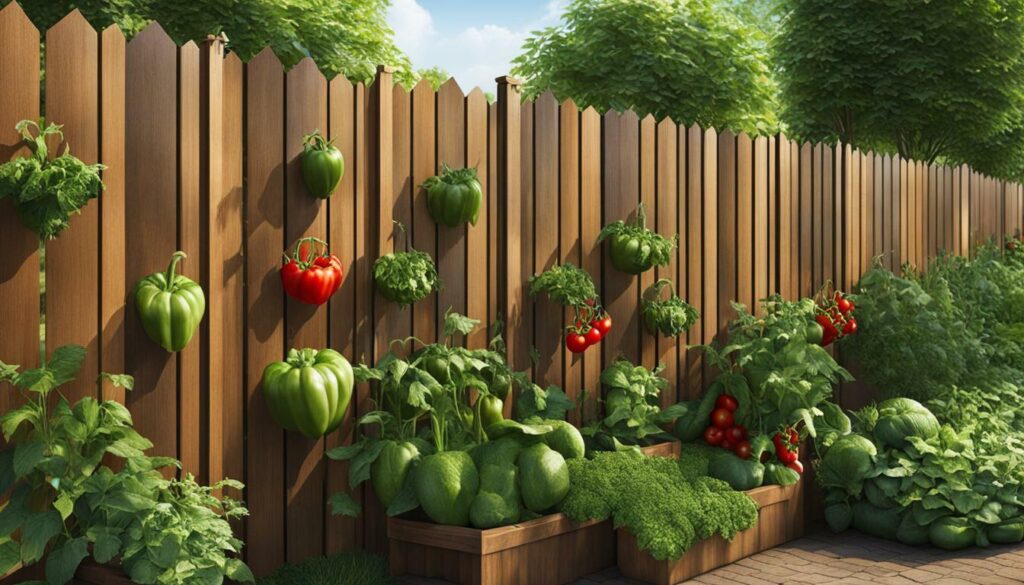
Summarizing the benefits of utilizing existing fences for vertical gardening:
- Maximize space by attaching hanging baskets or pots to fences
- Create a stunning display of plants and vegetables
- Grow a variety of plants that thrive in containers
- Utilize chain-link fencing for climbing plants
- Choose the right plants for vertical gardening on fences
With these techniques, you can make the most of your available space and enjoy the benefits of vertical gardening in your own backyard.
Wood Fencing for Vertical Gardening
Wood fencing made with flat boards can be easily transformed into a vertical garden by attaching a trellis or other grid-type material for climbing vegetable plants. This method not only maximizes space but also provides support for the plants to grow upwards. By utilizing the existing structure of the fence, gardeners can create a functional and visually appealing vertical garden.
For fences with solid, wood-paneled construction, hanging baskets, pots, and other growing containers can be attached to the fence. This type of vertical garden is ideal for growing vegetables and fruits that thrive in containers, such as lettuce, radishes, strawberries, and herbs. The flat boards of the fence may not offer natural support for climbing plants, but the addition of a trellis or grid-type material provides the necessary structure for tendrils and twiners to grow.
Even low, picket-type fences can be utilized for vertical gardening. Both vertical and horizontal materials of the fence can be used as a support for climbing vegetables. Hanging planters can also be secured to the top of this type of fence, making it convenient for the gardener to reach and maintain the plants.
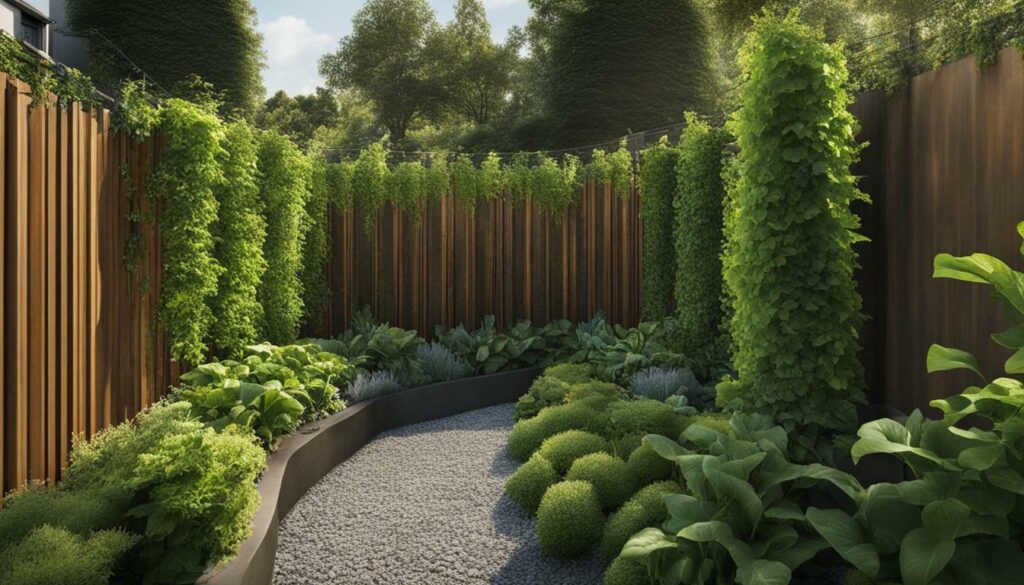
| Recommended Vegetables for Vertical Gardening on Wood Fencing | Recommended Varieties |
|---|---|
| Lettuce | Buttercrunch, Romaine, Red Leaf |
| Radishes | Cherry Belle, French Breakfast, Watermelon |
| Strawberries | Eve’s Delight, Albion, Seascape |
| Herbs | Basil, Parsley, Thyme, Rosemary |
“By thinking vertically, you’ll find a surprising amount of gardening space where there was none before.” – Source
Utilizing Chain-Link Fencing for Vertical Gardening
Chain-link fencing, while not the most aesthetically pleasing, can serve as an excellent structure for vertical gardening, providing ample support for climbing plants and transforming the fence into an attractive “solid” wall. This type of fencing is especially suitable for crops such as cucumbers, pole beans, peas, squash, tomatoes, melons, and pumpkins, which benefit from vertical growth.
One of the advantages of using chain-link fencing as a vertical garden structure is its ability to allow climbing plants to thrive. By planting these types of crops near the fence and providing them with some initial support, they can easily latch onto the chain-link and grow upwards, maximizing your available gardening space.
Another benefit of utilizing chain-link fencing is the visual appeal it can create. When fully covered with climbing plants, the fence turns into a lush “living wall,” adding beauty and greenery to your outdoor space. It can also provide privacy and act as a natural barrier between your property and the surrounding area.
However, it’s important to consider that most vegetable plants grown on chain-link fences are annuals, meaning they will die at the end of the season. This requires regular maintenance, as you will need to remove the dead vines and plant new crops each year. Despite this, many gardeners find the benefits of vertical gardening on chain-link fencing outweigh the maintenance involved.
Example Table:
| Crops | Recommended Varieties |
|---|---|
| Cucumbers | Marketmore, Armenian, Lemon |
| Pole Beans | Kentucky Wonder, Blue Lake, Scarlet Emperor |
| Peas | Sugar Snap, Snow, Oregon Sugar Pod |
| Squash | Zucchini, Yellow Crookneck, Butternut |
Remember to choose varieties that are suitable for vertical growth and have the ability to climb. These crops can bring life to your chain-link fence while providing you with a bountiful harvest.
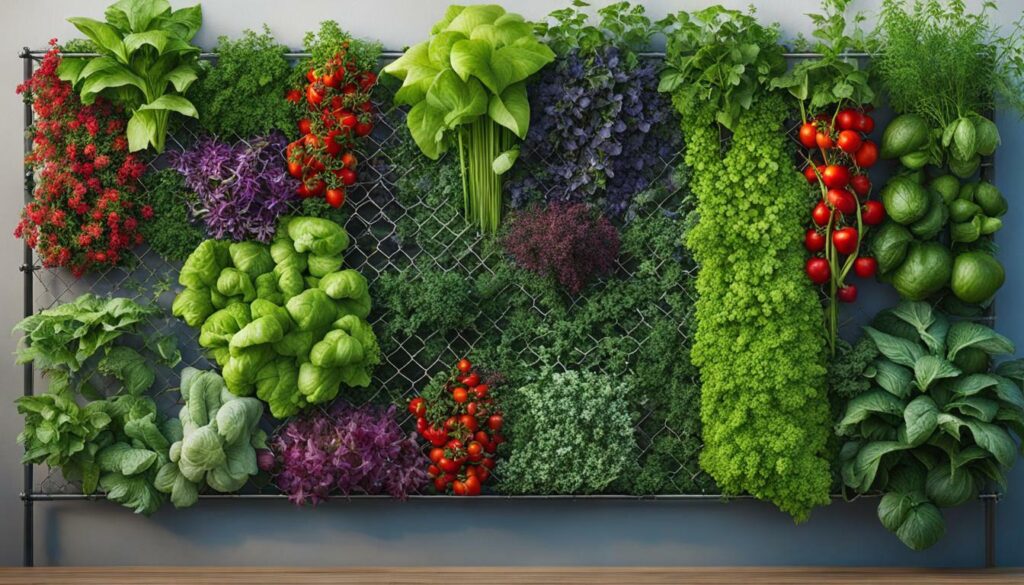
“By thinking vertically, you’ll find a surprising amount of gardening space where there was none before.”
Overall, chain-link fencing offers a practical and cost-effective solution for vertical gardening, enabling you to make the most of your available space while creating an attractive and productive garden. With proper care and maintenance, you can cultivate a thriving vertical vegetable garden and enjoy the benefits of fresh, homegrown produce.
Benefits of Solid Cement Wall Fences for Vertical Gardening
Solid cement wall fences offer a flat, secure top that is ideal for placing rectangular planter boxes, creating an instant vertical garden, and maximizing your gardening space. These sturdy fences provide a stable foundation for supporting climbing plants and offer numerous benefits for your vertical gardening endeavors.
Benefits of Solid Cement Wall Fences:
- Space Optimization: By utilizing the vertical space on solid cement wall fences, you can effectively grow more plants in a limited area. This is especially beneficial for gardeners with small yards or limited gardening space.
- Enhanced Plant Growth: The flat, secure top of solid cement wall fences provides a stable surface for rectangular planter boxes. This allows for proper root development and optimal plant growth. Additionally, the height of the fence ensures that the plants receive ample sunlight and air circulation, resulting in healthier and more productive plants.
- Improved Pest and Disease Control: By growing plants vertically, you can minimize the risk of pests and diseases affecting your crops. Vertical gardening on solid cement wall fences helps keep the plants off the ground, reducing the likelihood of soil-borne diseases. It also makes it easier to spot and address pest infestations.
- Easy Access and Maintenance: The elevated positioning of the plants on solid cement wall fences makes it convenient for watering, pruning, and harvesting. You can effortlessly care for your vertical garden without having to bend or kneel, reducing strain on your back and knees.
With solid cement wall fences, you can transform your outdoor space into a thriving vertical garden, filled with a variety of vegetables, herbs, or flowers. The versatility and aesthetic appeal of these fences make them an excellent choice for creating a visually stunning and productive garden.
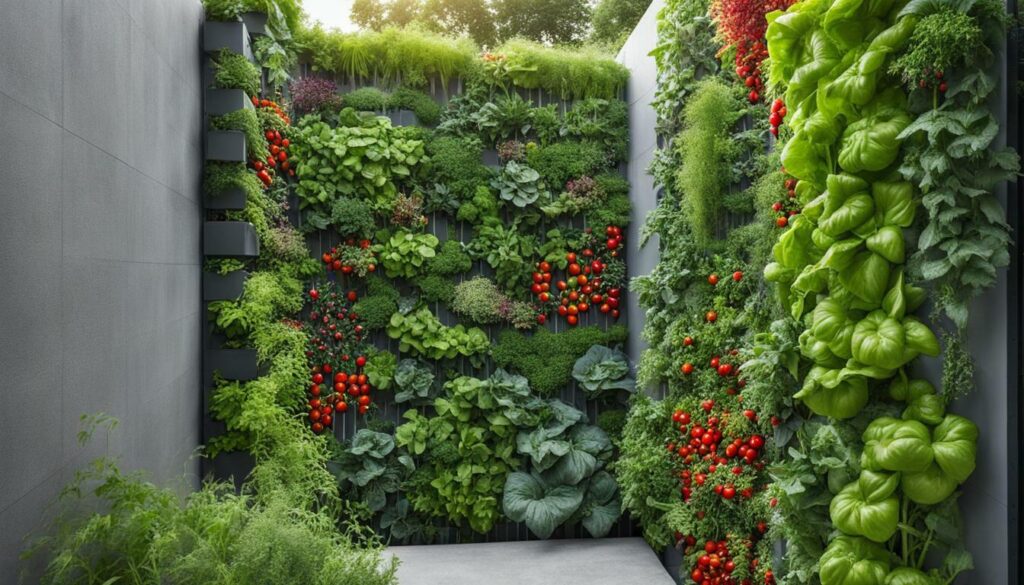
| Vegetables | Recommended Varieties |
|---|---|
| Pole Beans | Snow Cap, Kentucky Blue, Blue Lake |
| Cucumbers | Marketmore, Straight Eight, Lemon |
| Peas | Sugar Snap, Sugar Ann, Oregon Sugar Pod |
| Squash | Zucchini, Yellow Crookneck, Butternut |
| Tomatoes | Roma, Cherry, Beefsteak |
Remember to choose the right varieties of vegetables that are suitable for vertical gardening on solid cement wall fences. Ensure they have climbing or vining habits, as these types of plants thrive in vertical growing conditions. Proper plant selection and care will lead to a bountiful harvest and a stunning vertical garden display.
“Vertical gardening on solid cement wall fences allows you to make the most of limited space and achieve a lush and productive garden.” – Gardening Expert
Whether you have a small urban balcony or a spacious backyard, solid cement wall fences offer an excellent opportunity to create a beautiful and functional vertical garden. By taking advantage of this vertical space, you can enjoy the benefits of increased yields, reduced pest and disease issues, and easy access to your plants. Get creative with your planting choices and transform your solid cement wall fence into a stunning vertical garden oasis.
Choosing the Right Crops for Vertical Gardening
When choosing crops for a fence vertical vegetable garden, opt for vining, rambling, and sprawling plants that can be trained to grow up and off the ground, maximizing your available space. This type of gardening allows you to grow a wide variety of vegetables, from pole beans and cucumbers to tomatoes and squash.
According to experts, vining vegetables such as pole beans and climbing peas are ideal for vertical gardening. These plants naturally climb and can be easily trained to grow up a trellis, cage, or stake. Other great choices for vertical gardening include cucumbers, melons, summer squash, and tomatoes. These plants not only save space but also benefit from increased airflow, reducing the risk of soil-borne diseases and promoting healthier growth.
When planning your vertical garden, it’s important to consider the amount of sunlight your chosen crops need. Most vegetables require 6 to 8 hours of direct sunlight, so choose a location that receives adequate sunlight throughout the day. South-facing or west-facing surfaces are ideal for maximizing exposure to the sun. Additionally, consider using shade-tolerant varieties or providing shade cloth for crops that may be sensitive to excessive heat.
Recommended Crops for Vertical Gardening
Here is a list of recommended crops for vertical gardening:
| Vegetable | Recommended Varieties |
|---|---|
| Pole Beans | ‘Romano Italian’, ‘Meraviglia Venezia’, ‘Gold of Bacau’ |
| Cucumbers | ‘Burpee Hybrid II’, ‘County Fair 83’, ‘Dasher 11’, ‘Saladin’ |
| Tomatoes | ‘Sungold’, ‘Black Cherry’, ‘Gardener’s Delight’, ‘Blondkopfchen’ |
| Summer Squash | Acorn, Delicata, Yellow Summer, Zucchini |
“Vertical gardening allows you to grow more produce in less space by training plants to grow upward. It’s a great solution for gardeners with limited space.”
By selecting the right crops and utilizing vertical gardening techniques, you can make the most of your available space and enjoy a bountiful harvest. Whether you choose to grow pole beans, cucumbers, tomatoes, or other crops, remember to provide adequate support and regularly maintain your vertical garden to ensure optimal growth. With a fence vertical vegetable garden, you can enjoy the benefits of fresh, homegrown produce while maximizing your gardening potential.
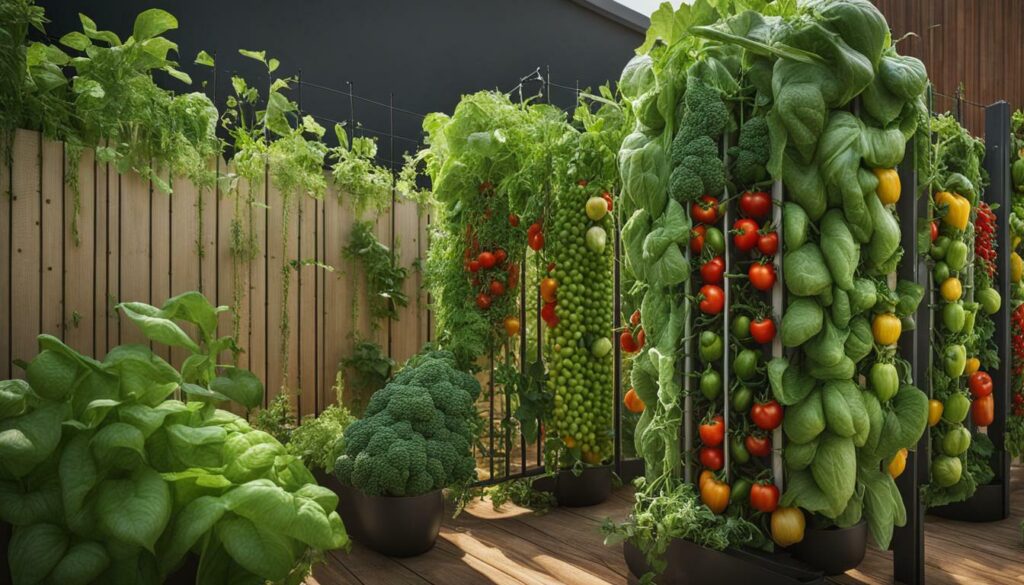
Different Types of Vertical Gardening Structures
In addition to trellises, tripods, and arches, there are a variety of structures that can be used for vertical gardening, such as gazebos, wire cages, netting, and bamboo poles, each suited to different plant characteristics and needs.
Gazebos provide a beautiful and functional structure for vertical gardening. With their open sides and roof, they allow for plenty of sunlight to reach the plants while also providing shade and protection from the elements. You can attach hanging baskets or planters to the sides and roof of the gazebo, creating a stunning display of cascading flowers or vegetables.
Wire cages are another great option for vertical gardening. They provide sturdy support for vining plants and can be easily customized to fit the space you have available. You can create a trellis-like structure using wire fencing or repurpose a wire tomato cage. Simply attach the cages to a wall, fence, or other vertical surface and watch your plants climb and thrive.
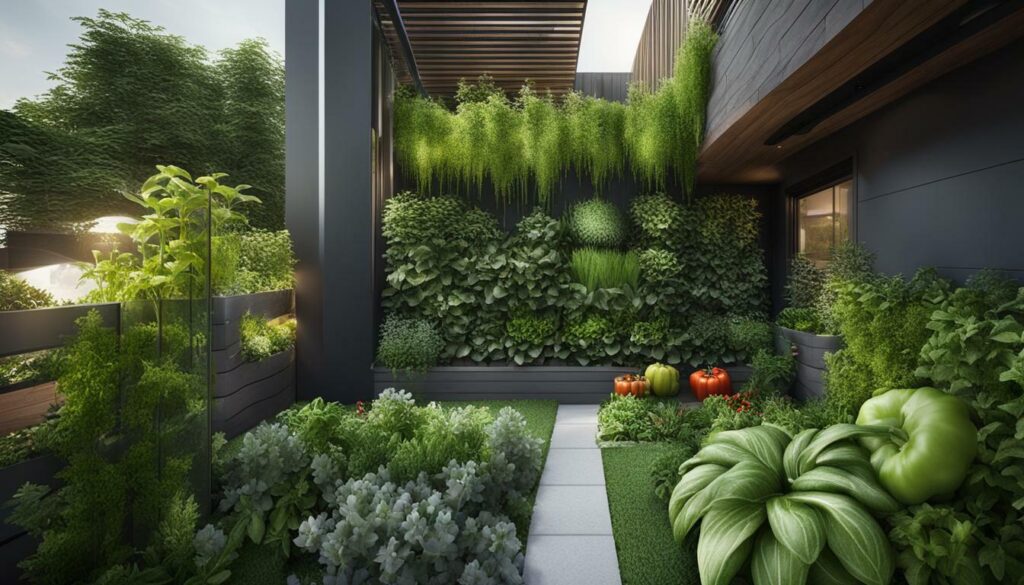
Netting is a versatile option for vertical gardening. It can be used to create a simple trellis by attaching it to poles or other supports. Netting is particularly useful for growing climbing vegetables like peas and beans, as it provides a lightweight and flexible structure for the plants to cling to.
Bamboo poles are a popular choice for vertical gardening due to their strength and durability. They can be used to create trellises, tepees, or arbors, providing ample support for climbing plants. Bamboo poles are also eco-friendly and sustainable, making them a great choice for environmentally conscious gardeners.
Benefits of Different Types of Vertical Gardening Structures
The use of different types of vertical gardening structures offers several benefits. Firstly, it maximizes gardening space, allowing you to grow more plants in a smaller area. Additionally, vertical gardening structures provide support for climbing plants, reducing the risk of damage or breakage. They also enhance airflow and sunlight exposure, promoting healthier plant growth and reducing the risk of pests and diseases. Lastly, these structures add visual interest to your garden, creating a vertical landscape that is both functional and aesthetically pleasing.
| Plant | Vertical Gardening Structure |
|---|---|
| Pole Beans | Wire Cage/Trellis |
| Cucumbers | Gazebo/Hanging Baskets |
| Peas | Bamboo Poles/Netting |
| Squash | Wire Cage/Gazebo |
In conclusion, the choice of vertical gardening structure depends on your specific gardening needs and preferences. Whether you opt for a trellis, cage, gazebo, or other structure, vertical gardening allows you to make the most of your available space while creating a beautiful and productive garden.
DIY Vertical Gardening Ideas
Get inspired by these DIY vertical gardening ideas, including creating a living wall with hanging pots, building a vegetable arch using metal uprights and cattle panels, and utilizing a vertical pallet garden for a unique and space-saving display.
One easy way to make a vertical garden in an attractive way is a trellis panel secured onto the wall to support a range of pots planted with herbs, vegetables, and flowers. Choose an appropriate-sized panel and give it a coat of wood stain or paint to protect it and help it stand out. Drill holes into the wall with a masonry drill bit, line them with wall anchors or rawlplugs, then screw in suitable strong L-shaped hooks. Plant up or sow your pots with low-growing crops like lettuce, pea shoots, bush beans, radishes, herbs, or flowers and secure them to the trellis with sturdy garden twine.
You can also make a productive walk-through vegetable arch using galvanized metal uprights and cattle panels. Clad with climbing crops like beans, cucumbers, and squash, the archway makes for easy picking and a stunning display. Locate your vegetable archway somewhere sunny and sheltered. Dig planting trenches on either side of the arch, then drive home the uprights corresponding to the width of the cattle panels. Backfill the trenches with a layer of nutrient-rich organic matter and the excavated soil. Cut the cattle panels to size and secure them to the posts using zip ties. Plant your archway trenches with climbing vegetables and add a layer of mulch for moisture retention.
A vertical pallet garden adds both functionality and aesthetics to any wall. You can plant a variety of items in your vertical pallet garden, including flowers, succulents, herbs, and vegetables. To build your own vertical pallet garden, you’ll need a wooden pallet, landscape fabric, and a staple gun. Make sure to choose a pallet that has not been treated with pesticides. Secure the landscape fabric to the back of the pallet using a staple gun, creating pockets for the plants. Fill the pockets with potting soil and plant your desired items. Hang the pallet garden on a sturdy wall or fence and enjoy your vertical oasis.
Table: Recommended Plants for Vertical Gardening
| Plant | Varieties |
|---|---|
| Cucumber | ‘Burpee Hybrid II’, ‘County Fair 83’, ‘Dasher 11’, ‘Saladin’ |
| Green bean | ‘Romano Italian’, ‘Meraviglia Venezia’, ‘Gold of Bacau’ |
| Cherry tomato | ‘Sungold’, ‘Black Cherry’, ‘Gardener’s Delight’, ‘Blondkopfchen’ |
| Pea | ‘Dual’, ‘Garden Sweet’, ‘Maestro’, ‘Sugar Snap’, ‘Super Sugar Snap’ |
| Melon | ‘Delicious 51’, ‘Tigger’, ‘Sleeping Beauty’, ‘White Wonder’, ‘Yellow Doll’ |
| Squash | Acorn, delicata, yellow summer, zucchini |
“Gardening in all three dimensions by using a fence, trellis, or other structure increases the growing area available to gardeners. Here are just a few of the benefits of vertical gardening: increased yields, reduced plant problems, better air circulation, and convenience.” – Source
Conclusion
By implementing a fence vertical vegetable garden, you can save space, boost your home’s appeal, and enjoy a bountiful harvest of fresh produce right in your own backyard. With the right crops and structures, you can maximize your gardening space and create a visually stunning vertical garden on your fence.
One of the key benefits of a fence vertical vegetable garden is the ability to save space. By utilizing the vertical space on your fence, you can grow a variety of vegetables without taking up valuable ground space. This is especially beneficial for those with small yards or limited gardening areas.
Another advantage of a fence vertical vegetable garden is the added appeal it brings to your home. The vertical structure adds visual interest to your yard and can act as a focal point or backdrop for other landscaping elements. It can transform an ordinary fence into a vibrant and lush garden, enhancing the overall aesthetics of your outdoor space.
In addition to space-saving and aesthetic benefits, a fence vertical vegetable garden also offers the opportunity to enjoy a bountiful harvest of fresh produce. By growing vegetables vertically, you can maximize the use of sunlight and promote better air circulation, leading to healthier and more productive plants. Plus, by having your own homegrown vegetables just a few steps away, you can enjoy the convenience of having fresh and organic produce at your fingertips.
When creating a fence vertical vegetable garden, it’s important to choose the right crops and structures. Consider the climbing and vining characteristics of various vegetables and select those that are well-suited for vertical growth. Additionally, explore different types of structures such as trellises, cages, and stakes that can provide support for your plants.
Whether you utilize existing fences or construct new structures, the possibilities for a fence vertical vegetable garden are endless. Get creative with DIY ideas and make the most of your vertical growing space. With proper planning and care, you can transform your fence into a thriving vertical garden that will not only maximize your gardening potential but also add beauty and functionality to your outdoor living space.
How Can a Vertical Garden on a Fence Maximize Space for Vegetable Gardening?
A vibrant vertical garden on a fence is a great way to maximize space for vegetable gardening. By using the vertical space, you can grow a variety of vegetables without taking up valuable ground space. This not only adds visual appeal to your fence but also provides a bountiful harvest.
FAQ
Q: What is a fence vertical vegetable garden?
A: A fence vertical vegetable garden is a method of growing vegetables vertically by utilizing a fence as a support structure. It allows gardeners to maximize their gardening space and grow a variety of vegetables in a small area.
Q: What are the benefits of a fence vertical vegetable garden?
A: The benefits of a fence vertical vegetable garden include saving space, minimizing pests and diseases, increasing yields, and making gardening tasks easier. It also provides better air circulation for plants and exposes more leaf surface to sunlight.
Q: How can I utilize existing fences for vertical gardening?
A: Existing fences can be used for vertical gardening by attaching hanging baskets, pots, and other growing containers to them. Trellises or grid-type materials can also be attached to fences to provide support for climbing vegetables.
Q: Can wood fencing be used for vertical gardening?
A: Yes, wood fencing can be used for vertical gardening. While flat boards alone may not provide support for climbing vegetables, attaching a trellis or grid-type material to the wood fencing can transform it into a suitable structure for vertical gardening.
Q: How can chain-link fencing be utilized for vertical gardening?
A: Chain-link fencing is an ideal structure for vertical gardening as it provides ample support for climbing plants. Hanging planters can be secured to the top of chain-link fencing, and when planted with foliage, it can become an attractive wall for vertical gardening.
Q: What are the benefits of using solid cement wall fences for vertical gardening?
A: Solid cement wall fences provide a flat and secure top surface, which is perfect for placing rectangular planter boxes to create an instant vertical garden. Vegetables such as peas can be planted in these planter boxes, growing down instead of up.
Q: Which crops are best suited for vertical gardening on fences?
A: Vining crops such as pole beans, climbing peas, sweet potatoes, vining tomatoes, and certain types of zucchini, cucumber, melon, and squash are well-suited for vertical gardening on fences. These plants can be trained to grow up on trellises or other structures.
Q: What are some DIY ideas for vertical gardening on fences?
A: Some creative DIY ideas for vertical gardening on fences include creating a living wall with a trellis panel and pots, making a vegetable arch using galvanized metal uprights and cattle panels, and building a vertical pallet garden using a wooden pallet and landscape fabric.
Q: How can I create a lasagna garden for vertical gardening?
A: While not technically a vertical gardening option, a lasagna garden can be used to grow a garden in small spaces. This method involves layering cardboard, water-absorbent materials, and compost to create a garden without digging into the soil. It is suitable for rooftop gardens and balconies.
Q: What is the importance of utilizing vertical space for gardening?
A: Utilizing vertical space for gardening allows gardeners to grow more plants in a smaller area, maximize their harvest, and make gardening tasks easier. It also provides better air circulation and sun exposure for plants, reducing the risk of disease and improving plant growth.

